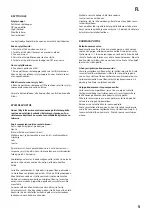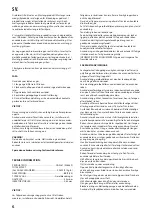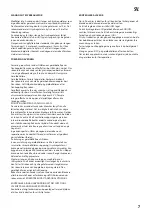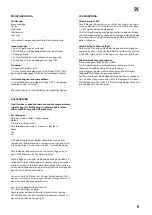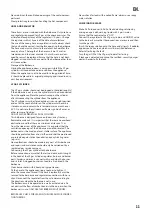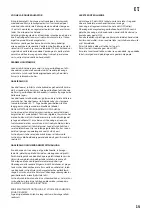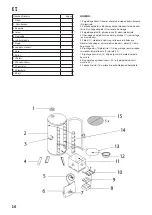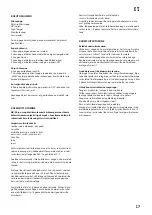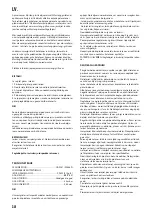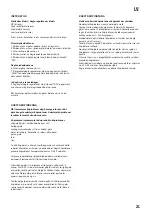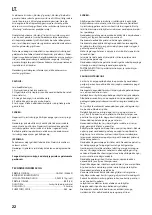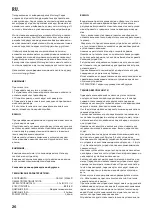
11
EN.
Never obstruct the ventilation openings of the container com-
partment.
Wear protective gloves when handling the hot components.
HOSE AND REGULATOR
These items are not included with the barbecue. Only use hose
and regulators approved for LP gas at the above pressures. The
estimated life expectancy of the regulator is 10 years. Change
the regulator within 10 years of the date of manufacture.
The use of the wrong hose or regulator is unsafe; always check
that you have the correct items before operating the barbecue.
The hose used must conform to the relevant standard for the
country of use. The length of the hose must be 1.2 metres
(maximum) and the inner diameter 10 mm. A worn or dam-
aged hose must be replaced. Ensure that the hose is not bent,
clogged, or in contact with any part of the barbecue other than
at its connection.
Storage of the Barbecue
Storing the appliance indoors is only permissible if the LP gas
cylinder is disconnected and removed from the appliance.
When the appliance is not to be used for a long period of time,
it should be placed in its original packaging and stored in a dry,
dust free environment.
LP GAS CYLINDER
The LP gas cylinder should not be dropped or handled roughly!
If the barbecue is not in use, the cylinder must be disconnected
from the appliance. Place the protective cap on the cylinder
after disconnecting the cylinder from the appliance.
The LP cylinder must be stored outdoors in an upright position
and out of the reach of children. The cylinder must never be
stored in an environment where temperatures can reach over
50°C. Do not store the cylinder near flames, ignition flames, or
other sources of ignition.
DO NOT SMOKE NEAR THE LP GAS CYLINDER.
This barbecue is designed for use outdoors, away from any
flammable materials. It is important that there are no overhead
obstructions and that there is a minimum distance of 1 m
from the side or rear of the appliance. It is important that the
ventilation openings of the barbecue are not obstructed. The
barbecue must be used on a level, stable surface. The appliance
should be protected from direct airflow and shall be positioned
or protected against direct penetration by any trickling water
(e.g. rain).
No modifications should be made to any part of this barbecue
and repairs and maintenance should only be carried out by a
registered gas service company.
Connecting the LP gas cylinder to the barbecue
Before connection, ensure that there is no debris or dirt caught
in the head of the LP gas cylinder, regulator, burner, and burner
ports. Spiders and insects can nest within and clog the burner
and its inlet. A clogged burner can lead to a fire beneath the
barbecue.
Clean burner holes with a heavy-duty pipe cleaner.
Fit the hose to the appliance using a spanner to tighten it
onto the connection thread. If the hose is replaced, it must be
secured to the barbecue and regulator connections with hose
clips. Disconnect the regulator from the cylinder according to
the directions when the barbecue is not in use.
The Barbecue must be operated in a well-ventilated area. Do
not obstruct the flow of combustion air to the burner when the
barbecue is in use. ONLY USE THIS BARBECUE OUTDOORS.
BEFORE USE, CHECK FOR LEAKS IN THE HOSE AND/OR CONNEC-
TION THREADS.
Never check for leaks with a naked flame, always use a soapy
water solution.
CHECKING FOR LEAKS
Make 2-3 fluid ounces (6-9 dl) of leak detecting solution by
mixing one part dishwashing liquid with 3 parts water.
Ensure that the control valve is “OFF”.
Connect the regulator to the LP gas cylinder and ON/OFF valve
to the burner. Ensure that the connections are secure and then
turn the gas ON.
Brush the soapy solution onto the hose and all joints. If bubbles
appear you have a leak, which must be rectified before use.
Retest after fixing the fault.
Turn the gas OFF at the LP gas cylinder after testing.
If leakage is detected and cannot be rectified, consult your gas
dealer in order to fix the leak.





